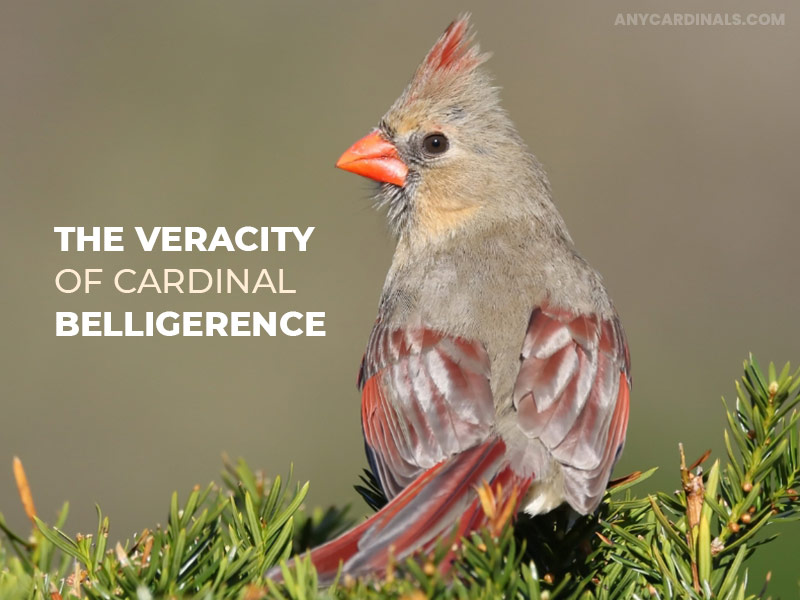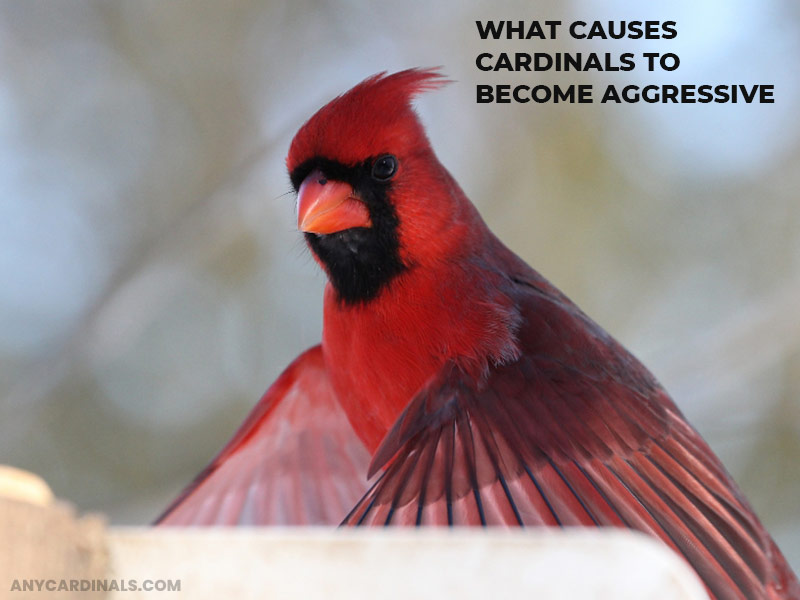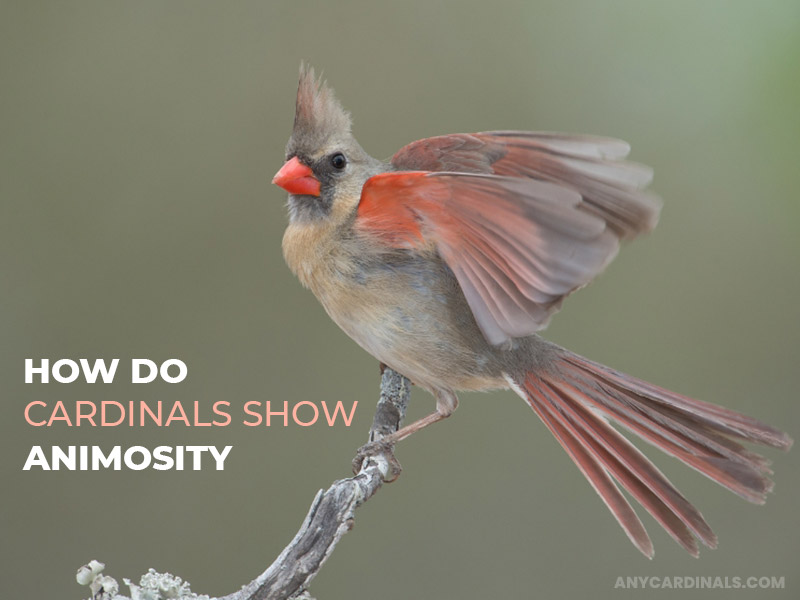Do Cardinals Attack Other Birds? Territorial Truths
Cardinals are famous for their striking feather colors, melodic songs, and behavioral traits. They draw the attention of many avian experts with their territorial behavior. But does that mean the cardinals are hostile? Do they hurt other animals? Or are cardinals aggressive to other birds?
In essence, it depends on the circumstances. Usually, cardinals don’t remain belligerent, and neither do they cause harm to other animals like predators. But they can go aggressive during the mating season and show aggression to other birds, animals, and even humans.
That said, if you want to know more about cardinals’ aggressive behavior, keep your peepers peeled through this content. Let’s get started.
Related blog about cardinals behavior:
- Cardinal Territorial Behavior and Hummingbird Interactions
- Cardinal Courtship: Is It Kissing or Feeding?
The Veracity Of Cardinal Belligerence:
Many people know cardinals as territorial birds for their aggression. These people have witnessed cardinals attacking other birds, fending off enemies, and possessing other aggressive traits. But cardinals aren’t alone in this realm of aggressive bird species.
Other birds are known to be as antagonistic as cardinals do. In essence, cardinals aren’t born as hostile birdies as people discern. In reality, these birds are social, friendly, and gentle and show little or no malice.

But cardinals can exhibit more aggression than other bird species when defending their territories, mates, and offspring. FYI, cardinals develop their defense mechanisms during the breeding season.
After pairing up, building nests, and laying eggs, both male and female cardinals remain bellicose throughout the breeding season. However, other times, they are gentle, shy, and loving bird species.
Studies show their aggression peaks during spring breeding, with males displaying 30% more territorial behaviors than songbirds like sparrows. Their aggression is typically defensive, not predatory, unlike raptors.
Triggers of Red Cardinal Aggression
Cardinals can be hostile for various reasons, one of which you already know, and that’s the breeding season. Hence, you can say they are protective instead of calling cardinals aggressive.
They will shield their family and take care of their family members even if they need to indulge in fights with predators and other birdies to ensure the safety of the family members.

Alongside this cause, another reason can trigger cardinals to go violent. It’s when they want to claim their territories. Before the mating season starts, cardinals must own territories to build nests. And to claim that they display aggressive traits to other birds but barely fight other birdies.
At its core, cardinals are gentle, peaceful birds, and they only go hostile while claiming territories, protecting offspring, and finding food sources during food scarcity. So, these are the prime causes why cardinals become aggressive.
Hormonal changes, particularly elevated testosterone in males during spring, drive their territorial aggression. Food scarcity in winter can also escalate competition, prompting defensive behaviors.
Times of Red Cardinal Aggressiveness
Cardinals can become hostile under many circumstances. For example, they tend to be aggressive when they feel threatened, especially during intruders’ invasion.
These birds don’t like gatherings and may fight with other birds or predators that try to sneak into their territory. Yes, nesting cardinals become extremely belligerent and defensive.
They often raise the alarm by singing loudly, flapping their wings, and shaking their tails to notify their families about potential threats.

Cardinals can also become bellicose while protecting food sources. During the winter, they suffer from food shortages, and at that time, they don’t like other birds wandering around for their food. If they find any, they will start fighting with those birds.
According to a recent study, cardinals remain close to their home and defend familiar territories all year round.
They can even attack bird feeders where other birds consume food if those feeders are installed in their territories. So, these are the times when cardinals become aggressive.
Their aggression peaks from March to June during nesting. Males may chase intruders up to 50 meters from their nest, using visual displays like crest-raising to intimidate rivals.
Red Cardinal Behavior Toward Humans
No cardinals aren’t hostile toward people; they are social, gentle, and peaceful birdies. They don’t belong to the group of birds that often attack humans and other animals.
But during those times mentioned earlier in this article, cardinals can show aggression toward people. Hence, we recommend you be aware of the situation and carefully handle those birds if they exhibit little aggression.

Typically, cardinals will warn you when you get too close to their nests or offspring. That means if you stop approaching them, these birds won’t have any reason to be hostile toward you.
FYI, cardinals tend to remain shy around humans, and some may leave their nests after being disturbed by people. But they won’t always show this kind of attitude, especially during the breeding period.
Rare cases of aggression toward humans involve males mistaking reflections in windows for rivals, leading to repeated pecking. This behavior subsides if reflective surfaces are covered.
Cardinal Interactions with Small Animals and Birds
As cardinals have a terrible reputation for being aggressive, many people perceive cardinals as predatory. They think these birds can prey upon small animals and birds. However, this isn’t the truth; cardinals are neither predators nor do they hurt small animals and birds.
But they prey upon bugs and insects, which don’t resemble their aggressive characteristics. They are the birds of love and kindness and never remain belligerent toward small animals and birds unless they feel threatened.
Their diet primarily consists of seeds and insects, not small vertebrates. They may chase smaller birds like finches from feeders during breeding season but rarely cause physical harm.
Do Cardinals Fight Other Cardinals?
Generally, cardinals don’t show hostility toward other cardinals. Even they are witnessed to tolerate other cardinals when these birds move into other cardinals’ territories.

But the scenario can turn into 180-degree when the breeding season starts. As you know, cardinals remain aggressive during this time, and they won’t tolerate the presence of other birds, humans, or animals at that time.
So, they will fight with intruders to make them leave their territories. Many people spot cardinals at this moment when they are fighting with other cardinals to impress mates and claim territories. That’s why those people assume that cardinals frequently fight with other cardinals.
How Do Cardinals Show Animosity?
Cardinals exhibit animosity following several steps. First, they choose to be vocal and emit high-pitched tones to scare off invaders. Then they dive into the land from the nests and chase off intruders.
Mostly, male cardinals perform such activities. Anyway, still, if a male cardinal fails to fend off enemies by yelling at them and chasing them, he will choose to indulge in a fight. And this kind of fight is sure to occur when the opponent is another cardinal or other small bird.

During the fight, the male cardinal uses his beak as a weapon. Mainly, he jumps at another bird and jabs that birdie using his sharp bill. Sometimes, a male cardinal attacks another bird from behind by leaping onto its back. But this is a rare case.
Mostly, cardinals don’t fight; instead, they stretch out their necks, fluff up their plumage, spread their wings, and fly toward enemies to scare them away. This is how they display their aggression.
Their aggressive displays often involve posturing, such as lowering their crest and fanning their tail, to appear larger. These non-contact behaviors are more common than physical fights, conserving energy.
Frequently asked questions
Do Cardinals Chase Off Other Birds?
Usually, cardinals don’t chase other birds unless they feel threatened during the mating season. Instead of chasing, they remain kind to others. For example, cardinals share food with other birds while consuming food from the same bird feeder.
During non-breeding seasons, they coexist peacefully with species like chickadees at feeders, showing tolerance unless food is scarce.
Do Cardinals Hurt Other Birds?
No, cardinals don’t hurt other birds. They aren’t hostile bird species but can be aggressive at a certain period of each year. Yes, they can show aggression to other birds during the breeding season and may hurt them.
Physical injuries are rare; their aggression typically involves chasing or vocal threats rather than direct attacks causing harm.
Are Cardinals Territorial With Bird Feeders?
Cardinals remain territorial in their feeding habits during the mating season. So, they will scare away other birds from the bird feeders at this time. Also, they can fight with other birds during the food shortage.
They prioritize feeders with sunflower seeds, defending them aggressively in spring but sharing them in winter flocks.
Tips for Observing Red Cardinal Territorial Behaviors
Best Times: Watch in spring (March-June) to see peak territorial displays.
Binoculars: Use binoculars to observe crest-raising or chasing without disturbing nests.
Feeders: Place feeders away from reflective surfaces to reduce mistaken attacks.
Plant Cover: Dense shrubs attract them, allowing safe observation of their defensive behaviors.
Conclusion:
Cardinals, these enchanting bird species, are social, friendly, and gentle. But some people know them for their aggressive behaviors. While it’s true that cardinals can display hostility when threatened, that doesn’t necessarily indicate that they belong to bold bird categories like predatory birds.
So, next time you hear someone calling them aggressive, you can tell them the facts regarding cardinals’ territorial traits, or you can share this content on Facebook, Twitter & Pinterest to let them know about the matter. That’s all for this article.
Image Credit: Canva.com/photos

